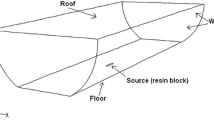Abstract
Simulated smoke has been widely used in place of actual fire smoke during flight tests in the certification process for aircraft cargo compartment smoke detection systems. Previous research has identified several differences between actual and simulated smoke. However, few studies have determined the quantitative effects of these differences on the transport and detection properties of actual and simulated smoke. The current work compared actual and simulated smoke using a computational fluid dynamics method with numerical models for the two types of smoke developed in the Fire Dynamics Simulator of the National Institute of Standards and Technology and validated through experimental data. The transport and detection properties of actual and simulated smoke were then evaluated quantitatively in detail. The two types of smoke were compared under two conditions: (1) at the same smoke-generating quantity and (2) at the same smoke release rate. Result showed that during the early stage of smoke occurrence, the numerical values of light transmission at different monitoring points in simulated smoke are 10% to 20% lower than those in actual fire smoke. Simulated smoke from the smoke generator is easier to detect than actual fire smoke. Therefore, the equivalence between simulated smoke and actual fire smoke should be focused on in the airworthiness verification of aircraft cargo smoke detection.
















Similar content being viewed by others
References
Blake D (2000) Aircraft cargo compartment smoke detector alarm incidents on unregistered aircraft, 1974–1999. Federal Aviation Administration, Washington, DC
Federal Aviation Administration (2014) Airworthiness standards: transport category airplanes Part 25.858, GPO’s Federal Digital System
Advisory Circular. AC 25-9A (1994) Smoke detection, penetration, evacuation tests and related flight manual emergency procedures. Federal Aviation Administration, Washington DC
Suo-Anttila J, Gill W, Gritzo LA, Blake D (2005) An evaluation of actual and simulated smoke properties. Fire Mater 29(2):91–107
Suo-Anttila J, Gill W, Gritzo L (2003) Comparison of actual and simulated smoke for the certification of smoke detectors in aircraft cargo compartments. DOT/FAA/AR-03/34, Federal Aviation Administration, Washington, DC
Blake D, Suo-Anttila J (2008) Aircraft cargo compartment fire detection and smoke transport modeling. Fire Saf J 43(8):576–582
Oztekin ES (2014) Heat and mass transfer due to a small-fire in an aircraft cargo compartment. Int J Heat Mass Transf 73(1):562–573
Lu KH, Mao SH, Wang J, Lu S (2017) Numerical simulation of the ventilation effect on fire characteristics and detections in an aircraft cargo compartment. Appl Therm Eng 124(1):1441–1446
Oztekin ES, Blake D, Lyon RE (2013) Fire induced flow behavior in a ventilated aircraft cargo compartment. In: 13th international conference and exhibition on fire and materials 2013, San Francisco, CA, United states, Interscience Communications Ltd, January 28–30.
Suo-Anttila J, Gill W, Gallegos C, Nelsen J (2003) Computational fluid dynamics code for smoke transport during an aircraft cargo compartment fire: transport solver, graphical user interface, and preliminary baseline validation. DOT/FAA/AR-03/49, Federal Aviation Administration, Washington, DC
Blake D (2006) Development of a standardized fire source for aircraft cargo compartment fire detection systems. Federal Aviation Administration, Washington, DC
Suo-Anttila J, Gill W, Gallegos C, Nelsen J (2007) Cargo compartment smoke transport computational fluid dynamics code validation. Federal Aviation Administration, Washington, DC
Wang J, Pan YY, Lu S, Lu K, Chen WS (2017) CO concentration decay profile and ceiling jet entrainment in aircraft cargo compartment fires at reduced pressures. Appl Therm Eng 110(1):772–778
Wang J, Lu S, Guan Y, Lo SM, Zhang HP (2015) Experiment investigation on the influence of low pressure on ceiling temperature profile in aircraft cargo compartment fires. Appl Therm Eng 89 (1):526–533
Wang J, Lu S, Hu Y, Zhang HP, Lo SM (2015) Early stage of elevated fires in an aircraft cargo compartment: a full scale experimental investigation. Fire Technol 51(1):1129–1147
Behle K (2006) Determination of smoke quantities to be used for smoke detection performance ground and flight tests. In: 25th Congress of the International Council of the Aeronautical Sciences 2006, Hamburg, Germany, Curran Associates Inc. September 3–8
Krull W, Willms I, Zakrzewski RR, Sadok M, Shirer J, Zeliff B (2006) Design and test methods for a video-based cargo fire verification system for commercial aircraft. Fire Saf J 1(4):290–300
Krull W, Willms I, Zakrzewski RR, Sadok M, Shirer J, Zeliff B (2005) A video-based cargo fire verification system for commercial aircraft: design and test methods. In: 8th international symposium on fire safety science, Beijing, China, September 18–23. Interscience Communications Ltd
McGrattan KB, McDermott R, Hostikka S, Floyd JE (October 2010) Dynamics Simulator (Version 5), User’s Guide, NIST Special Publication 1019-5, National Institute of Standards and Technology, Gaithersburg, Maryland
Mulholland GW, Croarkin C (2000) Specific extiction coefficient of flame generated smoke. Fire Mater 24(1):227–230
Krishnan SS, Lin KC, Faeth GM (2001) Extinction and scattering properties of soot emitted from buoyant turbulent diffusion flames. J Heat Transf 123(1):331
Author information
Authors and Affiliations
Corresponding author
Ethics declarations
Conflict of interest
The authors declare that they have no conflict of interest.
Additional information
Publisher's Note
Springer Nature remains neutral with regard to jurisdictional claims in published maps and institutional affiliations.
Rights and permissions
About this article
Cite this article
Chen, X., Shao, Z. & Yang, J. Comparison Between Actual and Simulated Smoke for Smoke Detection Certification in Aircraft Cargo Compartments Using the CFD Method. Fire Technol 56, 469–488 (2020). https://doi.org/10.1007/s10694-019-00887-9
Received:
Accepted:
Published:
Issue Date:
DOI: https://doi.org/10.1007/s10694-019-00887-9




